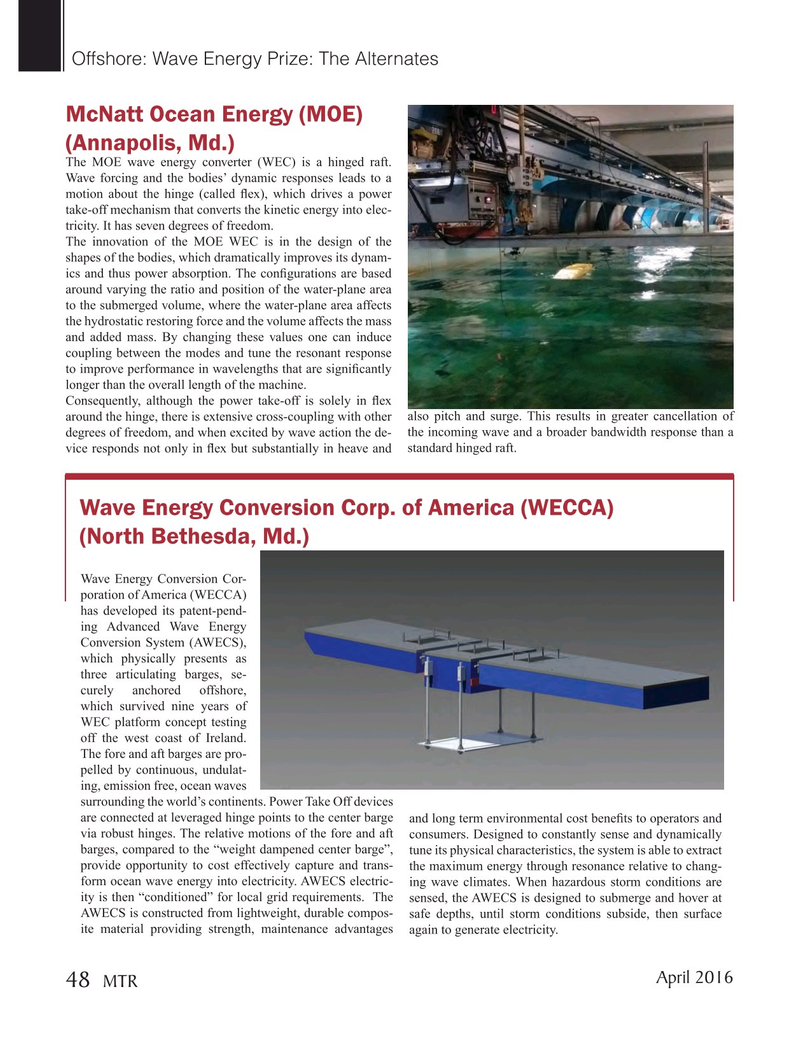
Page 48: of Marine Technology Magazine (April 2016)
Offshore Energy Annual
Read this page in Pdf, Flash or Html5 edition of April 2016 Marine Technology Magazine
Offshore: Wave Energy Prize: The Alternates
McNatt Ocean Energy (MOE) (Annapolis, Md.)
The MOE wave energy converter (WEC) is a hinged raft.
Wave forcing and the bodies’ dynamic responses leads to a motion about the hinge (called ? ex), which drives a power take-off mechanism that converts the kinetic energy into elec- tricity. It has seven degrees of freedom.
The innovation of the MOE WEC is in the design of the shapes of the bodies, which dramatically improves its dynam- ics and thus power absorption. The con? gurations are based around varying the ratio and position of the water-plane area to the submerged volume, where the water-plane area affects the hydrostatic restoring force and the volume affects the mass and added mass. By changing these values one can induce coupling between the modes and tune the resonant response to improve performance in wavelengths that are signi? cantly longer than the overall length of the machine.
Consequently, although the power take-off is solely in ? ex around the hinge, there is extensive cross-coupling with other also pitch and surge. This results in greater cancellation of degrees of freedom, and when excited by wave action the de- the incoming wave and a broader bandwidth response than a vice responds not only in ? ex but substantially in heave and standard hinged raft.
Wave Energy Conversion Corp. of America (WECCA) (North Bethesda, Md.)
Wave Energy Conversion Cor- poration of America (WECCA) has developed its patent-pend- ing Advanced Wave Energy
Conversion System (AWECS), which physically presents as three articulating barges, se- curely anchored offshore, which survived nine years of
WEC platform concept testing off the west coast of Ireland.
The fore and aft barges are pro- pelled by continuous, undulat- ing, emission free, ocean waves surrounding the world’s continents. Power Take Off devices are connected at leveraged hinge points to the center barge and long term environmental cost bene? ts to operators and via robust hinges. The relative motions of the fore and aft consumers. Designed to constantly sense and dynamically barges, compared to the “weight dampened center barge”, tune its physical characteristics, the system is able to extract provide opportunity to cost effectively capture and trans- the maximum energy through resonance relative to chang- form ocean wave energy into electricity. AWECS electric- ing wave climates. When hazardous storm conditions are ity is then “conditioned” for local grid requirements. The sensed, the AWECS is designed to submerge and hover at
AWECS is constructed from lightweight, durable compos- safe depths, until storm conditions subside, then surface ite material providing strength, maintenance advantages again to generate electricity.
April 2016 48
MTR
MTR #3 (34-49).indd 48 4/4/2016 9:48:59 AM

 47
47

 49
49
